How to Dry Sourdough Starter
I’m going to show you how to dry sourdough starter. Why? Because drying is the best way to preserve your sourdough starter for the long term.
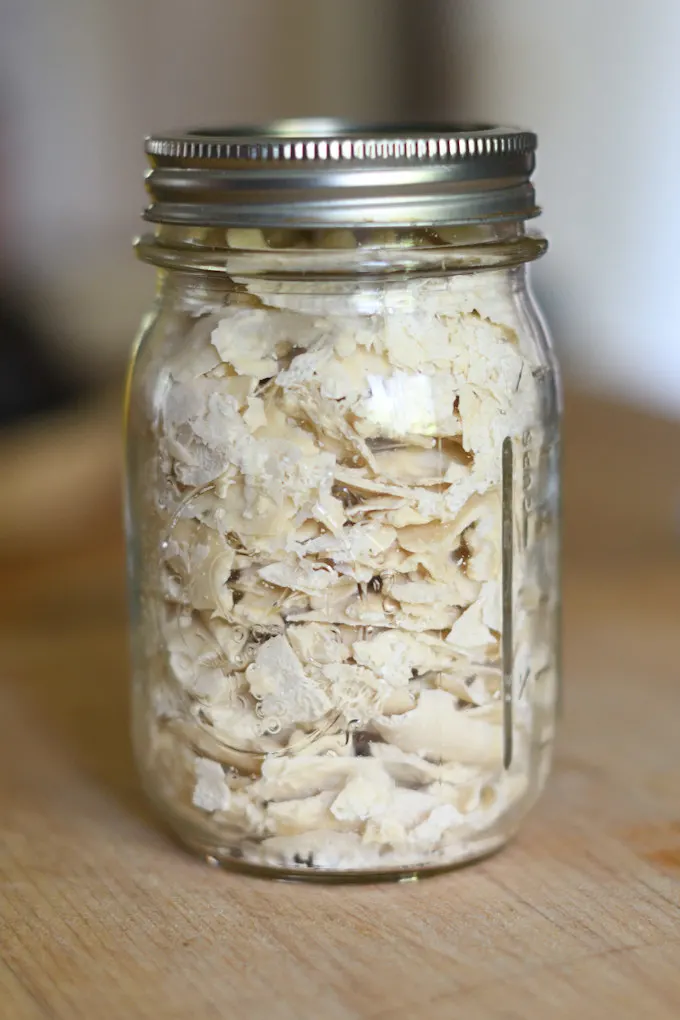
So you’ve jumped on the sourdough bandwagon, YAY! It’s so much fun, isn’t it?
But, there are times when real life interferes and you may not be able to bake for quite a while. Or maybe you want to share your starter with a friend who lives far away. Or maybe you just really hate to discard that discard.
The solution is this incredibly easy-to-do process for drying your starter. Once the starter is completely dried, your hard-won wild yeast goes dormant. The dried starter chips can then be stored indefinitely.
You can also pack some chips into a small envelope and mail them to a friend. I mailed some to my daughter who lives 3000 miles away. It’s a nice way to share from afar.
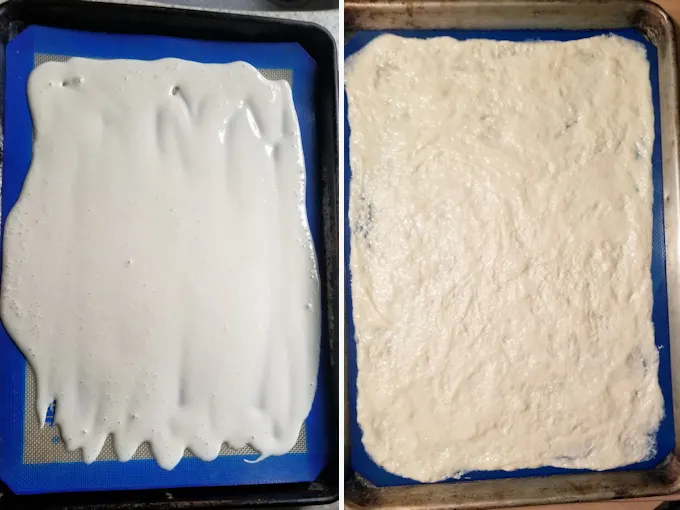
FAQs about drying sourdough starter and preserving sourdough starter:
I dried both a recently fed starter and sourdough discard which hadn’t been fed in over a week. I was able to revive both, but the dried sourdough discard did need an extra feeding before it was ready to use.
Yes, but don’t turn on the heat. Use the convection fan without heat or just leave the tray in the cool oven with the oven light on.
Yes. I used my dehydrator on the lowest temperature setting (90°F). It took about 8 hours for two trays of starter to dry.
Yes, it may take a bit longer but just leave it out at room temperature until it is completely dry and brittle. The time will vary based on the ambient humidity in your kitchen.
Indefinitely.
Add water and flour and wait for it to come back to life. Follow the instructions listed below. Also, you can grind the sourdough starter into a power which can be stored to rehydrate later or can be used directly in certain recipes.
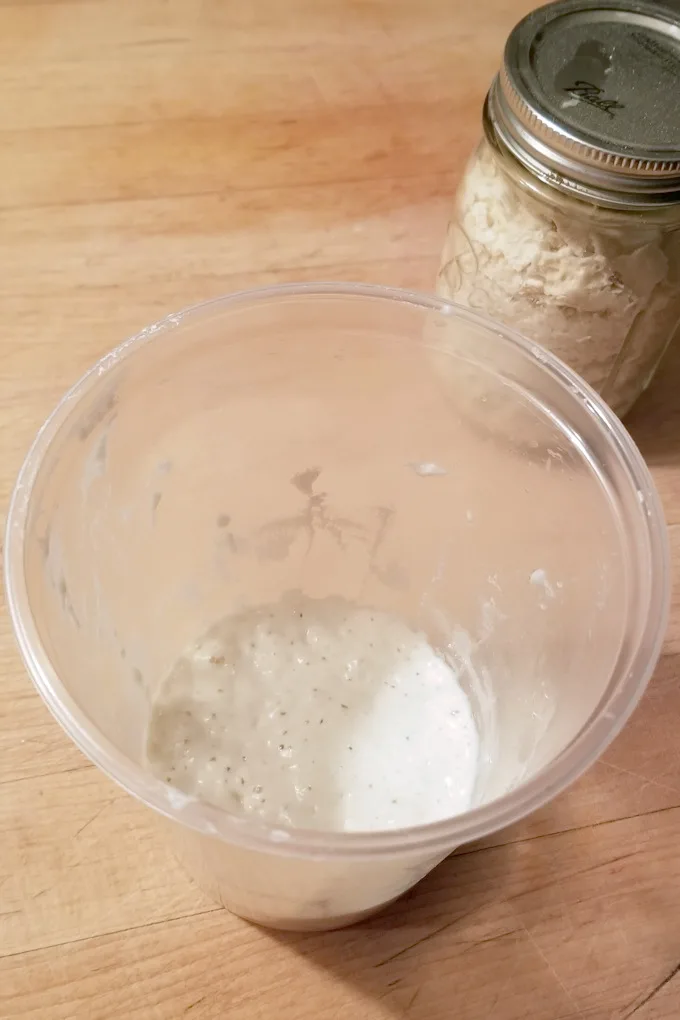
If you find this information helpful, I’d really appreciate a 5-star review!
How to Dry Sourdough Starter
Equipment
- Silicone Baking Mat or Parchment paper
- Half sheet pan
- Small spatula
Instructions
To dry the starter:
- Line the sheet pan with a silicone baking mat or parchment paper. The silicone mat works best so use it if you have one.
- Pour the starter onto the sheet pan and spread it out to a thin, even layer.
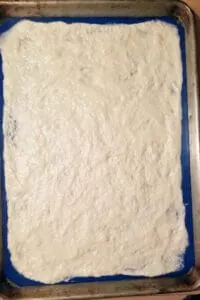
- Place the pan in a cool, dry place, uncovered. I put mine into the oven with the convection fan on and no heat. Alternately, if you have a food dehydrator you can use that on the lowest temperature.

- After 18-24 hours check the starter. It should peel off the mat. If underneath the starter is still moist you can peel it off, flip over the pieces and leave them to continue drying. If using a food dehydrator check after 6-8 hours.
- The starter is ready when it is completely dry and crisp. The texture should be like a potato chip which snaps when broken into pieces. You should have half the weight that you started with. If you started with 12 oz of starter you will get 6 oz of dried starter.
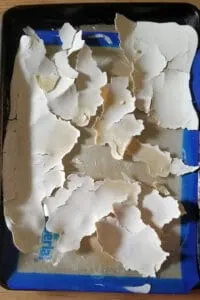
- Break the starter into chips and store in an airtight container at room temperature.
- The dried starter will keep indefinitely. The dried starter chips can be ground into a powder.
To revive the dried starter: (yield 9 oz of starter)
- Place 1/2 oz (14g) of starter chips or powder in a plastic or glass container. Pour 1 oz (28g) of warm water over the chips and stir to cover the chips with water.
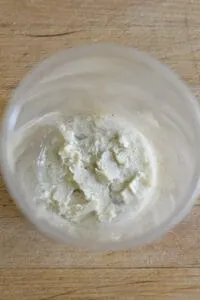
- Cover the container and set it aside until all the chips have melted into the water. This usually takes about 3-4 hours. The starter will not look active at this point.
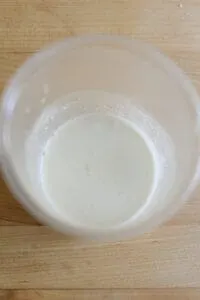
- Add another 1/2 oz (14g) of warm water and 1 oz (28g) of unbleached flour to the starter. Stir to combine. Cover and set aside for 4-6 hours. Now you should begin to see activity in the starter.
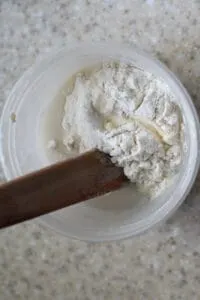
- Add 3 oz (84g) of warm water and 3 oz (84g) of unbleached flour to the starter. Stir to combine. Cover and set aside for 3-4 hours or until the starter has doubled in size and looks quite active.
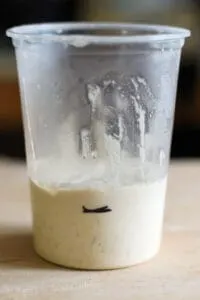
- If after 4-6 hours the starter still seems sluggish, discard all but 3 oz of the starter and do one more feeding.
- Use in your recipe as needed.
- The amounts listed can be multiplied out to yield more starter.

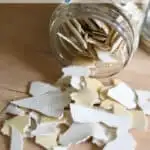

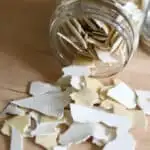
What if I also use rye flour in my starter and not just unbleached?
I often do a feeding with rye flour when I’m making rye bread or bagels. It’s no problem at all
Superb article. Thanks for your effort to write it to help us.
About 20, 25 years ago l bought what was claimed to be “oragon trail” sour dough starter. It arrived as a powder in the mail. The starter was weak. I messed around with it for a spellbut it was an underperformer.
So, I dehydrated the starter, blended in into a powder, vaccumn sacked some small sacks with a foodsaver and tossed the lot into the chest freezer and moved on. About 3 months ago I removed a sac of the stuff. I used pineapple juice and water to revive it. It came back to life after more than 20 years in the slammer. It was sill sluggish but it was alive.
So you can store this stuff long term, atleast the way I did it. Not sure about the freezing part but removing the O2 I think is a must. Iv had whole wheat flower stored in a sealed plastic bag with O2 absorbing packets stored in the freezer for 6 years, was still fine to use.
Fascinating!
I found some dried sourdough starter in my cupboard. Thank you for the directions. I am trying to revive it. Today 7 February 2021.
please learn to provide proper units of measure. learn the difference between volume and weight and when to use which.
ie: 14 grams of water?! your article while probably helpful reads ridiculously fast.
There’s no need to be rude. I weigh water in grams all the time when I’m feeding my starter.
LOL! Worst comment ever. Water can be measured in grams or volume.
not really. you can just use your regular kitchen scale to weigh your water.
1 gr=1ml
it’s not rocket science champ.
@James,
Why is that the worst comment ever?
Eileen wrote: “I weigh water in grams all the time when I’m feeding my starter.”
She didn’t say that measuring water in grams is the only way. She said that is her way to do that.
For the case of water volume always equals weight and so it is proper to use either!
And I find it actually easier if water is measured in weight since I am already using a scale for the sourdough starter and/or flour etc when baking and don’t need to take out a measuring cup just for the water. This way I’ll have more working space 😉
And EIleen thank you for this how-to, I’m gonna make a few dry starter batches to send out for Christmas!
I use weight specifically for this process because you’re working with such small quantities. Being exact with the measurements is even more important with you dealing with smaller measurement.
I always measure my water in grams. One millilitre of water is 1 gram in mass (ok – pure and at standard temp, etc., but it’s close enough for the kitchen to always assume this). A recipe given in baker’s percentages assumes the water is being weighed just like everything else. In fact, the only time I don’t weigh an ingredient is when I have a recipe from an American that I know just scoops flour and gives the measurement in volume. I have found that in that case, weighing the flour will result in too slack a dough/batter — so I’ll follow the scoop method then. Otherwise — weigh everything — it’s much more accurate. I have verified the volume of several kitchen wet measuring cups I have and have found the markings to be as much as 1 fl. oz. off. That may not sound like a lot, but it can make the difference between success and mediocrity.
no need to be rude., Instead of learning about sourdough you need. learn to be polite
If you are unhappy with the way the author writes recipes simple go to another site.
Sourdough really isn’t rocket science.
.It has been around for centuries and they certainly did not have the conveniences for measurement that are available today
I appreciate the authors willingness to share her thoughts and ideas
@ponyboy,
It seems you haven’t been able to pass elementary school. Let me enlighten you. The SI standard of weigh based on the volume of water. 1 liter of water in room temperature is 1 kg. 1 kg = 100 dkg = 1000 g
1 kg water = 1000 ml
1 dkg water (10 g for the weak in mind) = 1 cl (10 ml)
@Impatient_Teacher, no need to be insulting. Many if us have years of valid experience without a scale. Scales are useful but much excellent baking had been done for centuries without one. Metrics have not always been taught in school..thank you for your help
@ponyboy, this is a very valid measurement. As we know 1 liter of water equals 1000 g or ml of water. It is just much easier to measure 14 g on a kitchen scale than 14 ml in an container. Possibly on a not plum surface.
@Liz Reynolds, I never measure my starter feedings and all four of them are alive and well…so many happy bubbles. I go off of texture, look, and smell somehow I imagine 100+ years ago cooking in a cast iron pot over an open fire they didn’t really have a gram scale:-)
@Eileen Gray, I weigh the ingredients in grams as well.. I follow your instructions for dehydrating and rehydrating my sourdough starter